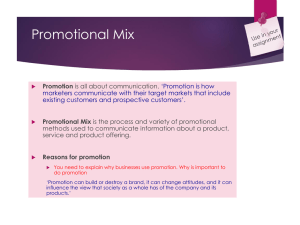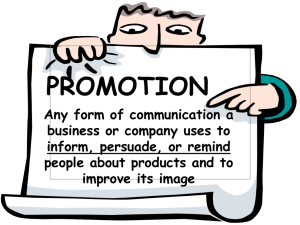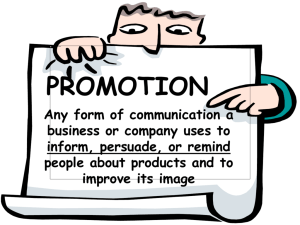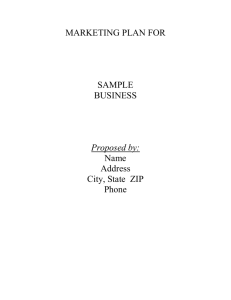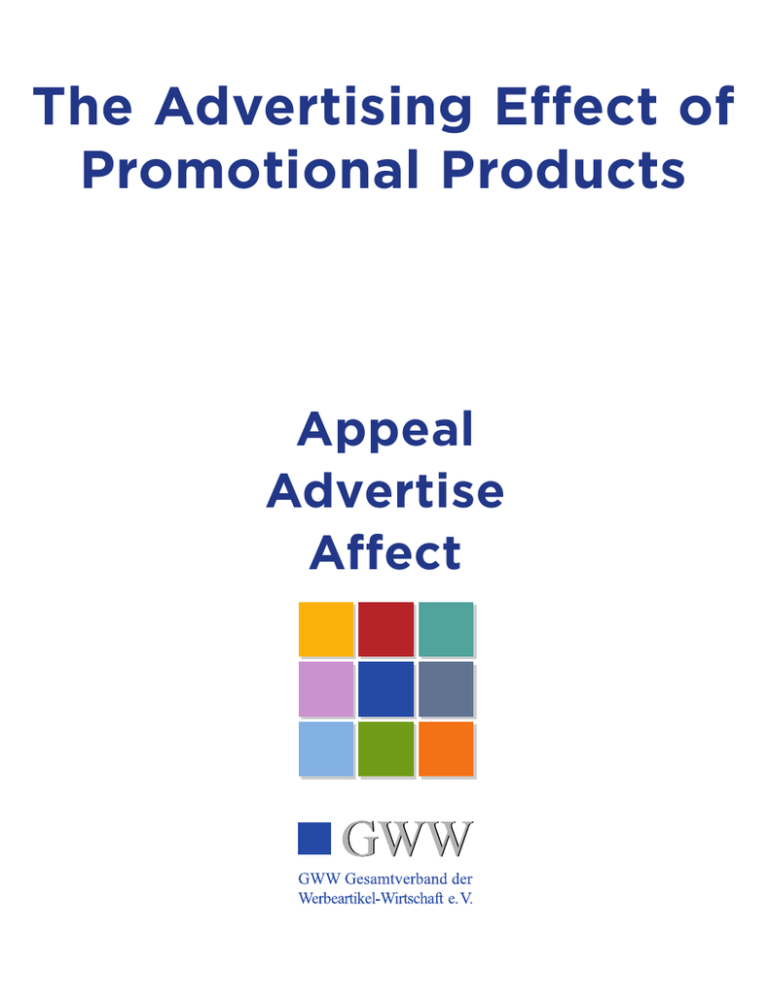
The Advertising Effect of
Promotional Products
Appeal
Advertise
Affect
AS YOUR ESCORT
Hans-Joachim Evers,
Chairman
Gesamtverband der
WerbeartikelWirtschaft e.V.
Promotional products are a marketing instrument. In every networked system,
promotional products are also put to use
in advertising campaigns. And for good
reason, since people readily accept promotional products. They are happy to get
them. This is an advantage that not every
advertising tool can claim for itself – as
we all well know.
Hence traditional TV commercials or
printed advertising must struggle with
problems related to a significant loss of
advertising recall. The commercial break
during a feature film, for instance, is seen
as just that – as an opportunity to go the
refrigerator or simply zap around. Promotional products, by contrast, cannot be
separated from their advertising message.
It cannot be "switched off".
Advertisers hold this in high esteem,
especially in networked advertising systems, to overcome the deficits of other advertising tools. However, this has not
sunk in yet in all parts of society and politics. We still run up against the preconceived opinion that promotional products
are more like a gift than an effective advertising tool. To combat this, the Gesamtverband der Werbeartikelwirtschaft (German Promotional Product Association,
GWW) has commissioned a highly respected institute to conduct an impact study.
The upshot of this fundamental study was
that promotional products had acceptance
values that beat nearly every other advertising medium. They are therefore indispensable, especially when used as part of
an effective interplay between a wide variety of different form of communication.
This is a form of advertising with enormous potential, because effectiveness is
convincing – and will surely convince
you, as well.
On this note,
Hans-Joachim Evers
Chairman of the GWW
ADVERTISING INFLATION IN GERMANY
Brand inflation
60,000
brands advertised
Media inflation
approx. 4,500
Collective Tinnitus
Werbebotschaften täglich
2,500,000
TV commercials per year
Budget inflation
Advertising expenditures +86%
Private consumption +45%
from 1991 to 2003
Source: ZAW, dmmv, IVW; GfK
The development of advertising in Germany is suffering from high inflation. More and more brands are trying to reach increasingly frugal consumers by way of ever more media with a steadily rising resource input
and under intensifying advertising pressure. The consequence is that consumers are being subjected to collective advertising tinnitus. In a nutshell,
Germany is being dominated by a threefold communications inflation: inflation at the level of brands, at the level of media and at the budget level.
THE WEAKNESSES OF TRADITIONAL ADVERTISING
Some consequences of this advertising inflation – already widely acknowledged – are for
one thing a growing rejection of advertising
among the general populace and for another
a drastic loss of effect for traditional forms of
advertising in print and on TV.
"Old-fashioned commercial-break television
is dead."
Bernd M. Michael, Chairman & CEO
Grey Global Group EMEA
"Seventy percent of today's TV commercials
go up in smoke to no effect."
Johann Lindenberg, former Unilever boss
Traditional advertising is often incapable of getting over the first hurdle, perception. And when the brand message does not reach consumers, the deeper advertising effect goes entirely unnoticed. The established forms of advertising, whether they be printed ads or TV commercials, usually need the
support of other advertising vehicles. These vehicles must meet with a more
positive acceptance and attain greater awareness (perception of the advertising message). Networked communication is the name of the solution.
WHAT IS IT THAT MAKES AN ORDINARY
PRODUCT A PROMOTIONAL PRODUCT?
Nearly every product can be used as a promotional product. Classic examples are ballpoint pens and calendars. New and innovative products, such
as USB devices or perfume bottles, also qualify. Depending on the requirements, advertisers will choose a suitable product for an advertising campaign and put the desired message on it. This gives the advertising campaign that certain kind of buzz.
PENETRATION: UNAIDED AWARENESS
X-awareness of the brands tested
Print advertising
(n = 100)
24
TV commercials
(n = 100)
49
Promotional products
(n = 200)
72
0%
10%
20%
30%
40%
50%
60%
70%
80%
Question: Can you recall the advertising in Stern magazine / surrounding Stern TV / on the promotional products? Please try to remember: which brands or companies were advertising?
Reading example: On average, the brands tested generated unaided
awareness of 72 % by advertising with promotional products.
Source: Advertising Impact of Promotional Products. Advernomics 2005
Advertising recall is the key factor determining the effectiveness of advertising. Advertising that is not perceived and whose contents are not internalized by consumers is worthless. A survey of unaided penetration (asking questions without naming brands) is the most reliable indicator for the
effectiveness of advertising. It clearly shows that promotional products really are much stronger than other forms of advertising in this sense.
ACCEPTANCE OF SELECTED
FORMS OF ADVERTISING
Scale from 1 (= I find them very annoying)
to 6 (= I do not find them annoying at all)
TOP 3 BOX (n = 400)
Promotional products
Arithmetic
mean
21
4.7
33
Magazine ads
Ads in movie theaters
4.2
42
3.8
TV commercials
66
Prize competitions on TV
3.0
76
Advertising in the mailbox
2.5
78
0%
10%
20%
30%
40%
50%
60%
70%
2.4
80%
Reading example: Of those surveyed, 78 % consider advertising in
the mailbox to be annoying. A mere 21 % of those surveyed consider promotional products to be annoying. With an arithmetic mean of
4.7, promotional products came off as not being annoying.
Source: Advertising Impact of Promotional Products. Advernomics 2005
When companies advertise, they choose their advertising channels with
great care. Advertising media that consumers find annoying, that is,
which have a low acceptance, generate a defensive reaction. This can go
so far as to cause the brand or the company to be categorized as less appealing. Advertisers thus make use of the high acceptance of promotional
products in order to offset the acceptance deficits of other advertising tools
and to enhance the acceptance of the advertising campaign as a whole.
ACCEPTANCE OF PROMOTIONAL
PRODUCTS IN DETAIL
Scale from 1 (= I do not agree at all)
to 6 (= I agree entirely)
Promotional products groups
TOP 3 BOX (n = 200)
Arithmetic
mean
76
I like getting these articles.
I like companies that use promotional
products.
70
Corporate logos on promotional products
do not bother me.
I would give priority to products from
companies who give me promotional
products, even if there is no difference in
price and quality.
66
4.2
4.1
43
3.1
73
I get promotional products much too seldom.
4.6
4.6
0% 10% 20% 30% 40% 50% 60% 70% 80%
Reading example: Of those surveyed in the promotional products
groups, 76 % are happy to get promotional products.
Source: Advertising Impact of Promotional Products. Advernomics 2005
A key challenge for advertisers is to design advertising that is well accepted by those it is intended to reach. As we all know, they are not always
successful in their attempts. Promotional products are the best way to take
this hurdle with ease. People are glad to get them (76 %). They like companies that advertise this way (70 %). And they would like to have more
such products (73 %). This clearly demonstrates the great potential hidden
away in this form of advertising.
Summary
■ Promotional products are very well accepted and consumers are happy to get them.
■ Promotional products are many times more effective than printed ads or TV commercials.
■ Advertising on promotional products reaches consumers and can be deployed in a
targeted manner (minimizing waste coverage).
■ Thus promotional products have a good chance of making a lasting impression (the
products are appealing, work well and are thus kept and used for a long time).
■ Promotional products solve both core problems of traditional communications instruments – they are well accepted and their message is perceived by consumers.
■ Using promotional products in a network with other advertising tools greatly enhances
their chances of success.
Appeal
Advertise
Affect
Conception and Design of the study "Advertising Impact of Promotional Products":
Advernomics GmbH
Imprint
Publisher: Gesamtverband der Werbeartikel-Wirtschaft e.V. (GWW), Neuss
Responsible: Board of the GWW
Idea + creation: Edit Line Kommunikations-Design, Mainz
Texts: Simon Dietzen, Manfred Schlösser
Layout: Nicki Abele, Malte Allenstein
Rights: All rights reserved, Gesamtverband der Werbeartikel-Wirtschaft e.V. (GWW)

